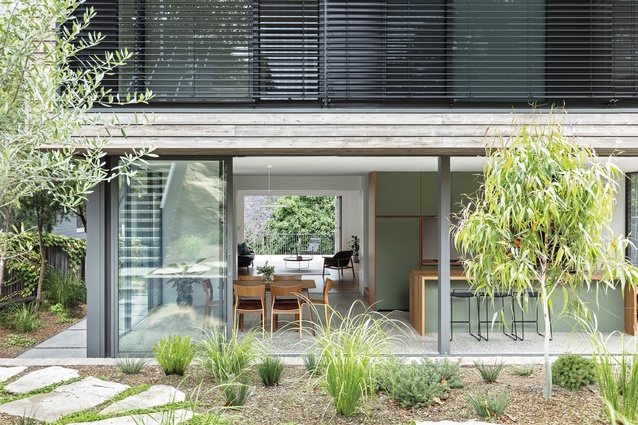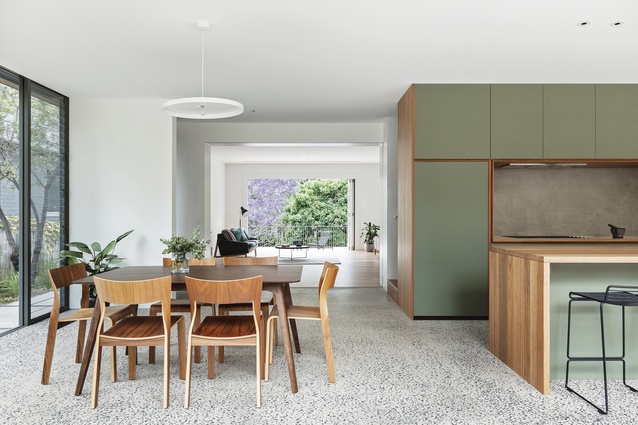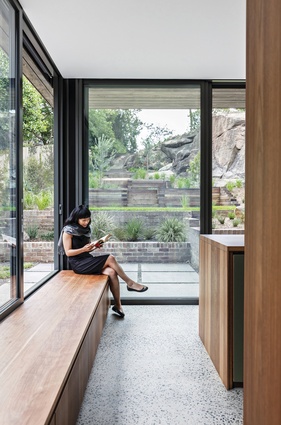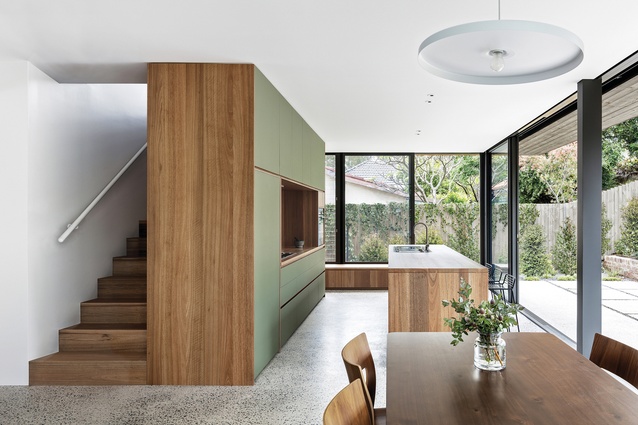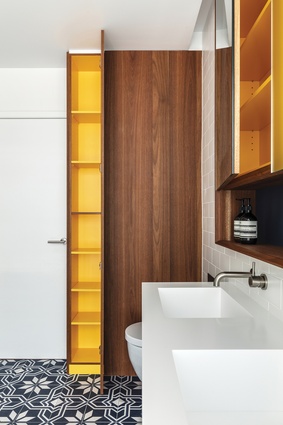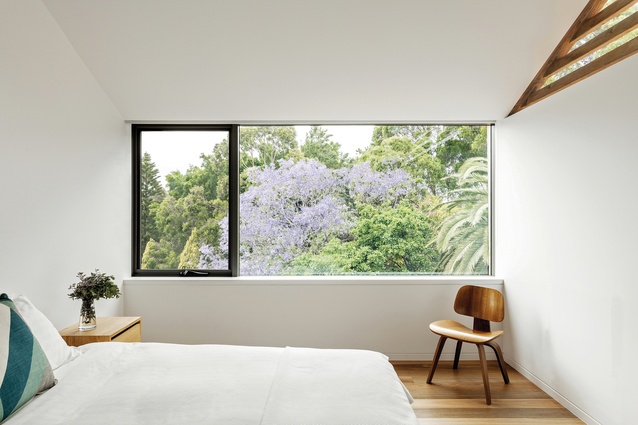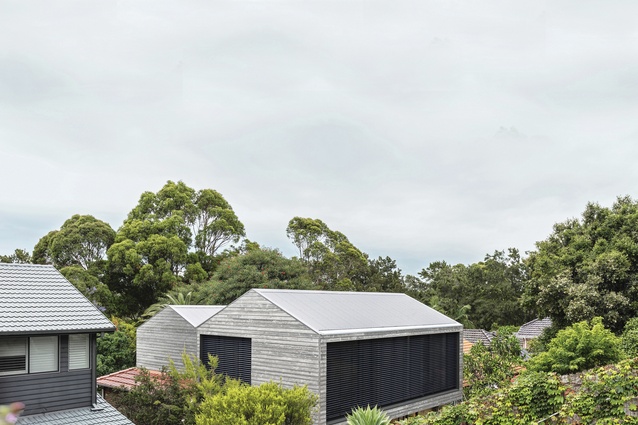Suburban escape: Cooks River House
Immersed in a tumbling hillside garden, this reworking of a Federation-era bungalow in Sydney’s Inner West eschews suburban tropes in favour of spaces that foster connection with the landscape.
Sydney’s Inner West has pockets of strong suburban character, with Federation and Californian bungalows lining the streets. But step through the front gate at Cooks River House and suburbia is left behind. A landscape of rocky outcrops and native plants terraces down the hill, seeming to flow right through the house to the Cooks River Foreshore. The property’s owners, Bob and Emily, have a fondness for the Blue Mountains and wanted the architecture and landscaping to evoke the wild, natural feeling of a national park.
Designed by Studio Plus Three, Cooks River House is an alteration and addition to a Federation bungalow. The front of the house faced south to the river, and a previous northern addition didn’t let in much light, so with small rooms and limited windows, the interior was cold and dark. It also lacked connection with the landscape. Nevertheless, surrounded by sandstone and trees, the house and its overgrown garden felt like a mountain home to Bob and Emily, who saw it as an adventure-filled environment in which to raise their three children.
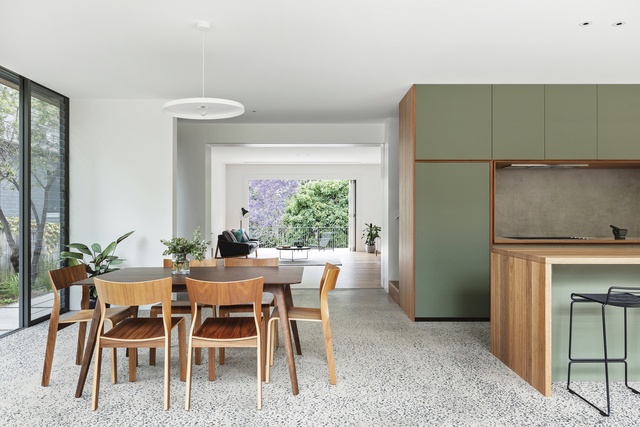
“It was challenging working with such a difficult landscape and a house that was so awkward on the site. We worked to marry them together so that every room has a connection to the landscape,” says Joseph Byrne, co-director of Studio Plus Three. As the surroundings formed an integral part of the concept, Studio Plus Three worked with landscape designer Christopher Owen, director of Fieldwork Associates, from the beginning of the project.
Using the existing footprint and the original bungalow structure, Studio Plus Three designed a two-storey house, keeping the additions natural and minimal in response to the setting. The lower volume has an open interior and sliding glass doors, minimizing the form to create a continuous sense of landscape. The timber-clad upper volume has a contemporary profile that extends beyond the glass walls and grey steelwork of the ground floor, yet maintains the massing and gabled roof of the bungalow as well as the neighbouring houses.
From the top of the site, the upper volume of the house appears to float over the lower volume. As you walk down through the landscape – past native plantings, a sandstone cliff face and flat spaces for the children to play – the view through the house continues to open up, with a large south-facing opening framing the lower-garden tree canopy. A minimal steel and precast-concrete staircase perched atop the cliff face provides a more direct route from the garage to the house, where existing concrete slabs and new concrete pavers surround the addition.
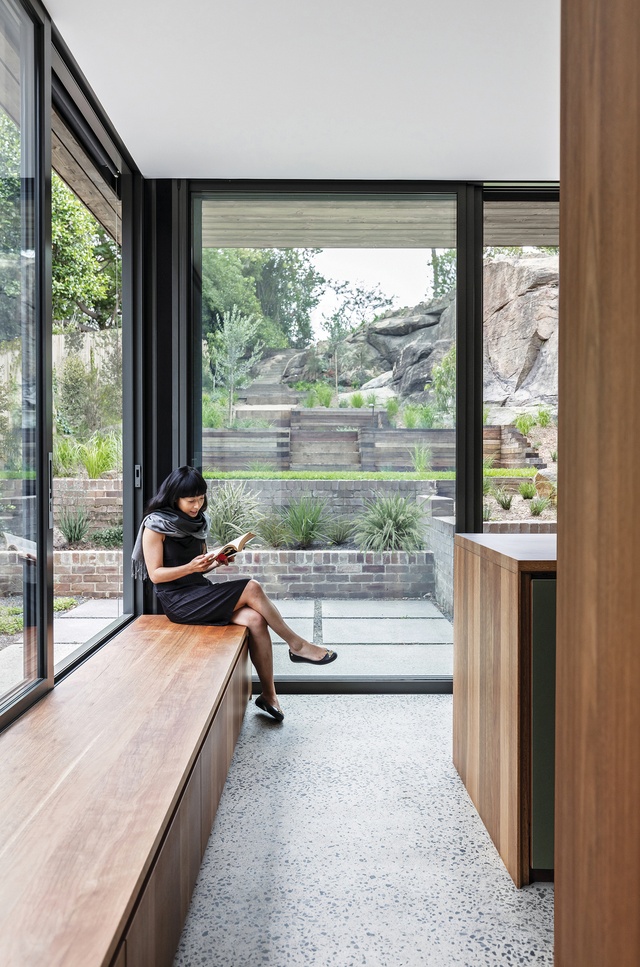
The front door is at the junction of old and new and its deep-purple colour, inspired by the Australian bush, is the first indication of Emily’s love of colour. The kitchen and dining area are part of the new addition and face north to the uphill landscape. Glass doors can be opened on all three sides, creating a pavilion-like feel, and the deep overhang of the upper volume serves as an eave to obstruct the summer sun.
To merge the architecture and the landscape, Studio Plus Three used similar materials inside and out. The concrete flooring mimics the external slab and pavers; spotted gum is used for joinery throughout; and green linoleum in the kitchen works tonally with the garden.
A large door slides out of the wall to section off the kitchen and dining area from the living room for heating, privacy and acoustics. The living room’s timber flooring flows out to a south-facing timber deck that cantilevers over the lower garden. Here, where the brick front of the Federation bungalow is visible, the sandstone rock footings have been exposed to reveal the original construction and to marry the house with the landscape.
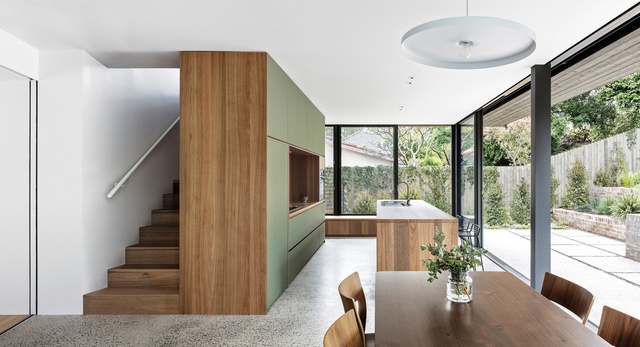
The corner bedroom has been retained, with a larger window inserted for light, and a second bedroom has been divided into a bathroom and a laundry. Spotted gum joinery is paired with blue linoleum in the bathrooms, and bright-yellow drawer and cupboard linings are a colourful surprise.
There are three bedrooms, a study and a family bathroom upstairs. Despite being one floor up, the spaces remain connected to the landscape, with every room offering a different aspect. Two children’s bedrooms have north-facing glass walls with external blinds and side windows for cross ventilation. A “bridge” to Bob and Emily’s bedroom creates a sense of transition as it passes into the pod-like form that sits atop and within the Federation roof. South-facing windows frame the tree canopy, and the gabled roof minimizes the visual impact of the house from the foreshore.
With landscape views from every room, and a rugged site to explore at the doorstep, Cooks River House complements the character of inner-suburban Sydney yet feels like it’s in the mountains. According to Julin Ang, co-director of Studio Plus Three, “It’s a humble, peaceful and serene refuge from suburbia, yet still a suburban house.”
This article first appeared on architectureau.com.

